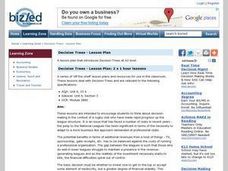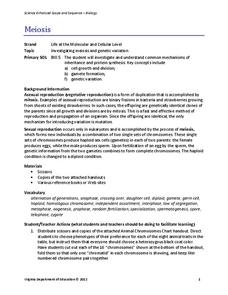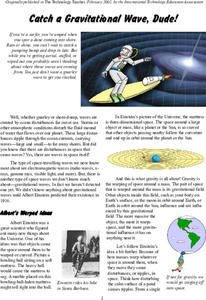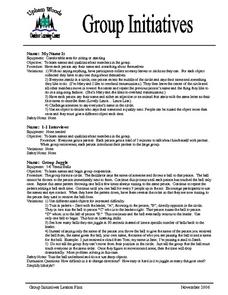Curated OER
Poetry: A Picture of Feelings
Students take a field trip to a place of interest. After the trip they share with a partner their most memorable memory about it. Later, they paint a picture representative of the trip and illustrate it with a poem using at least two...
Curated OER
Exploring the Planets
Learners study robotic spacecrafts that have provided detailed information about the inner and outer planets. In this exploring the planets lesson plan, students use posters and diagrams to study the various robotic spacecraft sent to...
Curated OER
Esperanza Rising: Lesson 8
Sixth graders complete activities with the book Esperanza Rising by Pam Munoz Ryan. In this literature lesson, 6th graders read Chapter 8 of the book and discuss the chapter. They practice putting events in sequence and record new...
Curated OER
Religion and Ethics: Living with Special Needs
Students explore human behavior by exploring mental and physical disabilities. In this learning disability lesson, students identify the different disabilities students have which prevent them from working at the same pace as the rest of...
Curated OER
Decision Trees
Students explore the decision-making in the context of a rugby club who have made rapid progress up the league structure. They construct a decision tree using the information given and calculate a final value to make quantitative...
Curated OER
DNA and Protein Synthesis
Tenth graders work with a partner, and copies of the attached worksheet "Amino Acid Codon Table" They discuss ways an organism, obtains and uses proteins. Students view a teacher prepared DNA strand banner, and record the complementary...
Curated OER
Biogeochemical Cycles
Students demonstrate comprehension of the energy sources of various cycles by completing mini stories. They demonstrate analysis of words by defining individual word parts and combining them to form definitions. Students demonstrate...
Curated OER
A Series of Intolerable Events
Eighth graders investigate the events that led to World War II. In this Holocaust lesson, 8th graders research primary and secondary sources about the events that led to the war. Students create PowerPoint presentations that provide...
Curated OER
Our Friends or Foes
In this living organisms worksheet, 6th graders choose the multiple choice answer to 10 questions. Students then read and answer 10 statements as true or false and fill in the blanks to 5 statements.
Curated OER
Science Drawing
In this drawing in science activity, students read about what is needed to complete a drawing in order to communicate ideas and discoveries in science. Students analyze a drawing of a volcano and indicate the problems with the drawing....
Curated OER
Strong Collocations 3
In this strong collocations learning exercise, students complete multiple choice questions where they fill in the blanks to sentences with strong collocations starting with the letter a. Students complete 20 questions.
Curated OER
Lesson 5: Designing an Experiment
The intent of this instructional activity is to introduce young scientists to the steps of the scientific method. To this end, they consider the question, "Which brand of battery lasts longest?" In this case, the experiment is carried...
Curated OER
The Dirt on Plants
Students draw and label the four parts of a plant. They describe changes that are part of the common life cycle. Students follow various one and two step directions. They are asked to discuss that they can recall about plants.
Curated OER
Meiosis
Using yarn and chenille stems, lab groups collaborate to model mitosis and meiosis. Brief background information and a vaguely written procedure comprise this outline. More instruction needs to be provided to learners about cell division...
Curated OER
Man in Conflict - Vietnam and Literature
Eleventh graders analyze the lyrics of protest music. In this Vietnam War lesson, 11th graders examine conflict as they consider the controversial nature of the war as evidenced in song lyrics. Students also consider the Iraq War and its...
K12 Reader
What’s Eating You?
Introduce your class to producers, consumers, and pollinators with a reading passage. Class members read the text and respond to five related questions.
Rocky Point Schools
Google Docs Lesson 1
The possibilities for effective collaboration, editing, and peer review are endless with Google Docs! This organized lesson plan details how to walk class members through establishing their Google Drive accounts, creating and sharing...
California Federation of Chaparral Poets, Inc
Poetic Devices
Have everything you need to know about the elements of poetry with a nine-page handout. Split into four categories—word sounds, meanings, arrangement, and imagery—budding poets may reference terms, read definitions, descriptions, and...
May Media Group
Treatment Plants
Young scientists explore nature's water treatment plants in this simple science demonstration. By placing a stalk of celery in a cup of water mixed with food coloring, children are able to observe how plants absorb nutrients and...
Curated OER
Acid Rain
Create a simulation of acid rain in your classroom with lemon juice and bean plants to help kids study the effects of pollution on plants. In addition, learners will listen to a story and write responses based on guiding questions.
NASA
Catch a Gravitational Wave, Dude!
It is cowabunga time! Pupils read an article about the NASA LISA mission on gravitational waves and conduct additional research on them. The class participates in a science bowl type competition about gravitational waves. Panels of four...
Curated OER
One Small Act
Students perform acts of kindness. In this caring lesson, students brainstorm ideas for acts of kindness. Students select their favorite idea and work in groups to make a plan for how to carry out their act of kindness.
Curated OER
Group Initiatives
Students explore the names and qualities about members in the group. They each say their name and something about themselves. Students gather around in a circle. They listen to the teacher as he or she says the name of someone and throws...
Curated OER
Measuring Body Parts
Students engage in a lesson to measure body parts. They use the measuring tape to record the data of body measurements. Students must choose the appropriate unit of measurement and compare the data for the different parts of the human body.

























